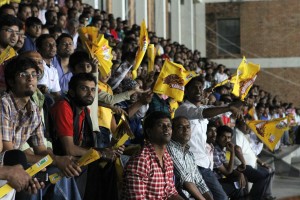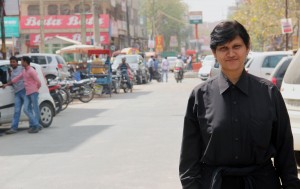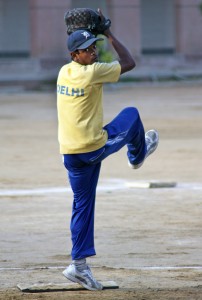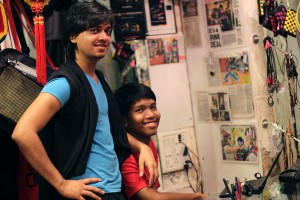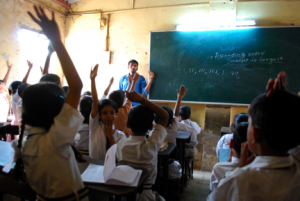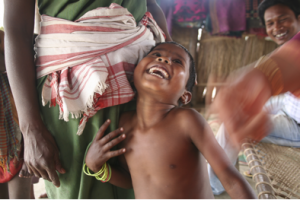By Elise Craig (class of 2010)
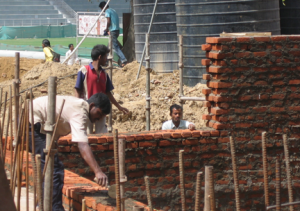 DELHI, India, April 2010—In a workers’ camp in Delhi, a little girl of three or four bathes herself out of a child’s plastic bucket. The girl is alone for the day–her parents are working on a construction site several kilometers away. About 400 migrant workers and their families are living here on a site called the Polo grounds as they build a new rugby stadium at Delhi University. The families live in “hutments,” 8×8 wooden structures with corrugated tin roofs that look like box cars laid end to end. Used water runs in a small murky stream between the buildings, there is feces on the ground, and swaths of flies pepper the air. There is no electricity. There is no plumbing. And all 400 families share nine toilets.
DELHI, India, April 2010—In a workers’ camp in Delhi, a little girl of three or four bathes herself out of a child’s plastic bucket. The girl is alone for the day–her parents are working on a construction site several kilometers away. About 400 migrant workers and their families are living here on a site called the Polo grounds as they build a new rugby stadium at Delhi University. The families live in “hutments,” 8×8 wooden structures with corrugated tin roofs that look like box cars laid end to end. Used water runs in a small murky stream between the buildings, there is feces on the ground, and swaths of flies pepper the air. There is no electricity. There is no plumbing. And all 400 families share nine toilets.
Across Delhi, construction is moving at a frenetic pace. Roads are being widened, and bridges and flyovers are being built to ease Delhi’s legendary traffic congestion. As cranes jut into the sky, sewers are covered, slums are dismantled, and construction signs promise that Delhi is on its way to being a “world class city.”
The city is being torn apart and rebuilt, spruced up and beautified all in the name of the 19th Commonwealth Games.
Migrant workers and their families who have come to Delhi in search of construction work are living in camps on sites and in makeshift tents along Delhi’s streets. The construction is everywhere—at Indira Gandhi International Airport, across the different campuses of Delhi University, on the riverbed, and along the skyline.
On the ground, taxi drivers are being taught English, and service workers are getting lessons in Western etiquette from the Delhi Tourism and Transport Company. Beggars are being arrested and relocated.
The Commonwealth Games are essentially the Olympics of the former British Empire, and the third largest sporting event in the world. The contest is expected to bring an estimated 5 million additional tourists to India, according the Associated Chambers of Commerce and Industry of India, and 72 different countries plan to field teams for the games, from Anguilla to Zambia. The contest will be held between October 3 and 14 of this year.
This is the first time that India has managed a successful bid to host the games, and only the second time that an Asian country’s bid has been accepted by the Commonwealth Games Federation. (The first was Kuala Lampur in 1998.)
“We are organizing a major sporting event in the country after a gap of 28 years, after the Asian Games in 1982,” Suresh Kalmadi, president of the Indian Olympic Association told journalists in March. “It’s a big challenge for us. You need to present a world-class event when the whole world is watching. You need to showcase everything on a large scale.”
The games are also a training ground for India to prove to the world that it is capable of hosting a large-scale international sporting event, and push aside fears or bias against holding the games in a developing country. The stakes are also particularly high, as Kalmadi has said publicly that India will be submitting a bid to host the Olympic Games in 2020.
“India and Delhi dedicate themselves to making the Commonwealth Games the best games ever held…one that will inspire goodwill, friendship and unity,” the IOA wrote in its bid to the Commonwealth Federation.
With an Olympic bid on the line, the pressure is on for Delhi to pull off a successful and memorable games, and the IOA originally set a budget of $1.6 billion (79 billion rupees) to cover the cost—not including non-sports related infrastructure like the Metro. That figure would make the 2010 games the most expensive in history–the next closest in cost were the 2006 games in Melbourne, which cost $1.1 billion. But by March, that figure had swollen to nearly $3 billion (ck), and the government announced new taxes on everything from tea to cell phones.
The games are being marketed as Delhi’s ticket to entering the world stage, and an investment in infrastructure that will improve the city for its residents. And many of the city’s residents agree. “It was sold to the middle class in such a beautiful way, most of them say it’s fantastic,” said Krishnendu Bose, a filmmaker who made a documentary on the environmental impact of the games called “Delhi: Work in Progress.”
But in Delhi, environmentalists and human rights activists are asking who will really benefit from the games—the people of Delhi, or the government and business interests who will profit from them?
“It’s a very big question—do we need these games?” said Harsh Bora, 21, a law student at Delhi University. “It might be a pride issue. But the games are wearing down our self-esteem. Half of our children are malnourished. That money could be used better.”
On the side of a road a few blocks from Delhi University’s School of Economics, migrant workers are living with their families in tents made of blue tarps. The conditions are similar to the Polo Grounds: no access to running water, toilets or electricity. On this particular street, the families have come from poorer states around Delhi to build sidewalks, or footpaths, for the Municipal Corporation of Delhi in preparation for the games.
Ram Khiladi, 30, and his wife Lali, 27, came to Delhi in search of construction work to feed their young family. “We have a piece of land,” he said,” but there is no water.” So when a subcontractor came to his village with offers of unskilled construction work, he and his wife packed up their eight-year-old daughter Priyanka and eighteen-month-old baby Pintu and moved to the streets of Delhi. They plan to continue working until their job runs out in two months, and then, somehow, stay in Delhi.
“It’s okay work, as long as we can get it,” Ram said.
But, when he and his wife go to work, they have to leave Priyanka to baby-sit for her baby brother. There is no crèche, or daycare center, to care for them. In India, the law requires a crèche on construction sites where women work.
“I am scared, but there is no other option,” Lali said, as she breast-fed her baby. “When we leave our kids behind, we just have to leave them with the other kids.”
Priyanka, a small girl with close-cropped hair and a gold stud in her nose, does not go to school, both because she must watch her baby brother, and because they are not registered citizens of Delhi.
“In the village, she used to go to school, but now she can’t,” Lali said. “She misses it, she wants to go.”
According to Ram, he and his wife are paid 250 rupees per day, far above Delhi’s minimum wage for unskilled labor, which is 152 rupees per day. He says they work six days a week, but are paid for seven, as is required by law, and claims that the workers have access to doctors when they need them, and that “injuries are rare.”
But Bora, the Delhi University student, says that workers’ answers to questions about safety and payment have changed since India’s High Court appointed a committee to go through the labor camps and investigate claims that contractors were violating labor laws.
“It’s as if they’ve memorized everything,” he said. “Before the committee came through, they told the truth about what they were being paid, and the doctors. This, this is what they have to say.”
In January, a civil liberties group called the People’s Union for Democratic Rights (PUDR) filed public interest litigation with the High Court of Delhi. They presented information from a fact-finding report they had written months earlier that said workers were not being paid minimum wage, they were not being paid on time, they were not being paid equally, and other violations of labor laws. They were also concerned that injuries and deaths from accidents were being under-reported.
PUDR had filed a similar piece of litigation with the Supreme Court in 1982, when Delhi hosted the Asia Games.
“In the Asia [Games] judgment, we were not able to provide relief for any workers, because they had left,” said Moushumi Basu, secretary of PUDR and a professor of international politics. “This time, we’re trying to ensure that workers will benefit.”
PUDR chose to file to the High Court instead of the Supreme Court so that they would have a chance to appeal if the court dismissed the case. Instead, the court ordered a new committee to go into the labor camps and issue its own report on the laborers’ working and living conditions.
The Committee’s visits confirmed what PUDR had alleged in its report—that in many cases, construction workers lacked basic safety equipment like construction boots, hard hats and gloves. And the committee confirmed that 49 people have been killed in accidents on construction sites, while officials for the games had previously put the count at 6 or 7 deaths. (In comparison the total number of construction-related deaths in the U.S. in 2009 was 3.) Conditions in the camps were not up to legal standards.
The complicated structure of labor in the games also makes it easier for subcontractors to take advantage of workers, according to PUDR member Paramjeet Singh. Though the government is footing the bill for all of the projects, each project is awarded to a contractor. Each contractor has many subcontractors, and in many cases, even subcontractors who go to the villages and recruit workers. Contractors pay subcontractors by check, subcontractors pay the subcontractors who work under them, and eventually workers are paid in cash. In most cases, the committee found, there were no records of how much workers were actually being paid.
“It’s a chain of subcontractors,” Singh said. “By the time the rupee gets down the chain, there is nothing left for the workers.”
The committee issued its report on March 17, and what they found was, in the words of former India’s outspoken former U.N. representative Arundathi Ghose, “grim.”
“By and large,” Ghose said,” the situation was horrible, except for one site—the airport. We were not satisfied [the workers] were receiving minimum wage, which the contractors assured us they were.”
According to Ghose, contractors at many of the sites could not prove they had paid their workers wages, because they hadn’t kept records, registered their workers, or given them identification cards, all of which are required by law.
“The living conditions of people working on the flyovers, these people are being treated very badly,” Ghose said. “And we have called for exemplary punishment.”
The four-person committee, which included Delhi’s Secretary of Labour, Shri R. D. Srviataya, made a list of recommendations to the High Court, which specified necessary changes to living conditions and safety conditions, and ways to streamline labor laws and make punishments for contractors commensurate with their crimes. They also noted the importance of registering workers.
Registration of workers with the Labour office is particularly important, because under the Builders Act of 1990, contractors are required to pay one percent of the cost of every project into a welfare fund for workers. Given the cost of the games project, there is a significant amount of money available to workers, but only those who are registered.
“It’s a fine law on paper,” said Anjali Alexander, a volunteer at the Commonwealth Games Citizens for Workers, Women and Children. “If you ask me out of $11 million, how much has reached workers? No more than $34,000–$11 million is still sitting in the coffers of the fund. Hardly any workers know of the welfare fund.”
Sheila Dikshit, the third-term chief minister of Delhi, did not respond to multiple requests for comment by this reporter. Neither did Srviataya. Dr. Lalit Bhanot, organizing committee secretary did not respond to questions after he requested them in writing.
Even though the committee was presented with a “grim” view of conditions for workers, Ghose agreed with Bora—she believed that some workers were still not responding truthfully to the committee’s questions.
“We felt the workers in some sites were clearly being intimidated by workers crowding around us, ” she said.
Bora had been in the labor camps talking to workers before the Committee went in, and during some of their visits. He says that workers’ responses about wages and conditions changed between when he first went in and the Committee’s visit, and he thinks that the contractors were warned about what was supposed to be a surprise visit in advance.
Bora is a member of “Perspectives,” a student group at DU that goes on fact-finding missions and issues reports on social issues like displacement, farmer suicides and the agrarian crisis. In early 2009, the group decided to look into labor practices at CWG construction sites where the university was the main employer.
“Since we are all part of Delhi University, this is happening to us,” he said.
Perspectives went into the camps around the University and talked to 52 workers, and reported much of the same findings as the committee—workers were underpaid, it sometimes took months to get wages, there were no crèches or schools, no health facilities, and employees were not being paid a double rate for their overtime hours. They also reported similar safety violations.
But, Bora says, when he went with the Committee to a site that had previously not had a school it suddenly had one. Workers claimed higher wages. But, when he returned to the same site a week later with journalists, the school was empty, and there was no teacher.
Bora’s fellow Perspectives member, Shikha Pandey, experienced the same thing.
“One day before the inquiry, we met the workers and they started saying that they made 250, 300, or 350 rupees a day,” she said. “I knew some of the workers personally, and they told me they had been told to say that.”
Back on the side of the road by DU, a few tents down from Ram, a woman who would only give the name Khargi said the workers laying the footpaths were not being paid minimum wage—men were making only 120 rupees per hour, while women were making only 110. She also claimed that the contractors had told the employees to lie about their wages and living conditions, but that she didn’t care because she had to return to her village to care for a sick relative.
“I know I’m supposed to get more, but someone is taking a cut in the middle,” she said. “I know I’m not being treated fairly, but I don’t have the education to do anything about it,” she added.
Allegations of poor adherence to labor laws haven’t been the Commonwealth Games’s only criticism. The games have had other troubles as well.
Environmentalists like Ravi Agarwal, director of ten NGO Toxics Link have expressed concern about what the massive construction projects are doing to the city of Delhi.
“Land that you hitherto could not build on will now be commercialized, Agarwal said. “This land was something you could not build on. It was almost impossible. But the games have forced all rationality to fall by the wayside.”
Agarwal points specifically to the brand-new Commonwealth Games Village, where athletes will be housed. The facility is being built on a riverbed that was previously protected land. Permission was given to build on the site through the courts, so long as the facilities were temporary. But now, Agarwal says, the builders have already put out advertisements encouraging citizens to buy the flats after the games end.
“They wanted to make a Manhattan on the river,” Bose said. “And there is money to be made.”
Advocates of the games point to the new infrastructure the Games are bringing to the city—renovation of domestic and international new airports, sidewalks where there have been none, more flyovers to help people move more efficiently and brand new stadiums. But Bora and Devika Narayn, 23, a graduate student in sociology, say that these improvements are only in the neighborhoods where the wealthy middle class live, and that the stadiums aren’t a necessity. Neither student is excited about the brand-new rugby stadium going up on DU’s campus.
“No one knows what rugby is,” she Narayn. “If you ask anyone on the road, no one can tell you.”
Environmentalists are also concerned about the estimated 250,000 trees the city is cutting down for the construction, as well as the new concrete being poured throughout the city. Agarwal fears that more concrete—with holds more heat than earth—and fewer trees will adversely affect a city that is already sweltering in the summer and has a significant amount of air pollution.
“Tree have been an essential part of the city, and if you cut them off, the city changes,” he said. “The character, the temperature, the groundwater.”
Beyond construction, the government of Delhi is bringing other changes to the city to manage the games more efficiently. During the 12 days of the games, there will be no school in the city to help ease traffic. Students in the men’s hostel, or dorm, at Delhi University will have to move out for the duration of the games so that the hostel can host foreign athletes. The city is making efforts to get auto rickshaws off the streets, to get food stalls to close, and to allow only authorized “hockers” selling merchandise on the streets. And advocates fear that the same migrant workers who live on the streets while they build the infrastructure for the games will be removed from the city once they begin.
Agarwal is dismayed that Delhi is becoming what he considers an “antiseptic city.”
“Why do tourists come to Delhi? We don’t want to be a second-hand London. We want to be a first-hand Delhi. They want to make us London.”
Others have criticized the government for providing foreigners with things it does not provide its citizens—like “first-world drinking water” and food testers. Currently, 50 percent of the city’s residents don’t have clean water.
“The games have been converted into such a thing of prestige, like the Olympics sin Beijing, but are the citizens of Delhi–forget India–benefiting from it?” asked Alexander.
Despite the problems, Ghose believes they are. The problems, she says, are not with the games, but with construction standards in India, and the huge scale of construction in India’s capital is bringing attention to abuses that have so far gone unnoticed. And they are also bringing construction jobs to workers who have been pushed out of farm work by the agrarian crisis.
“I think it they’re giving jobs, [the games are] good for the country,” she said. “ But the Commonwealth Games are not going to put the country on the map—our growth rate is. It’s our overall geopolitical and economic strength that will put us on the map.”
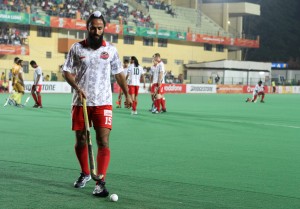 DELHI, India, July 19, 2012—In India, cricket is the national obsession, but it is actually field hockey that is its official game, with a more deeply embedded history within this patchwork of nations. Field hockey is the country’s most decorated international sport, and the men’s national team is the most accomplished in the Olympic event’s history—winners of 11 medals, including eight gold, dating back to 1928.
DELHI, India, July 19, 2012—In India, cricket is the national obsession, but it is actually field hockey that is its official game, with a more deeply embedded history within this patchwork of nations. Field hockey is the country’s most decorated international sport, and the men’s national team is the most accomplished in the Olympic event’s history—winners of 11 medals, including eight gold, dating back to 1928.